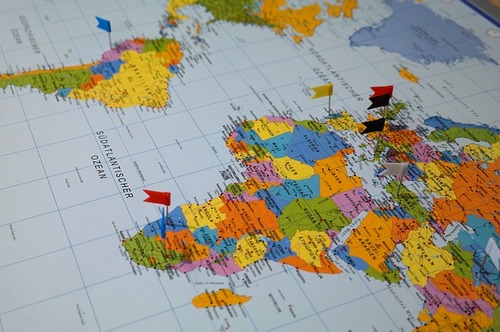The translation, localization and transcreation industry is estimated to generate $40 billion in annual revenues, with a 5.52 percent rate of growth. It’s expected to be a $45 billion industry by 2020.
The Common Sense Advisory maintains that demand for language services will continue to gain importance for all businesses, non-profit organizations, government agencies and individuals who are producing and consuming information.
The growing demand for language services is due to the continuing expansion of global ecommerce, the Internet of Things (IoT) and new laws requiring language services for refugees and immigrants.
As of now, over half of the internet is in English. More precisely, the lingua franca and internet language of today is ‘international English,’ which is is not distinctly British or American, for example.
In his book Asian Englishes: Beyond the Canon, author Braj B. Kachru says that 533 million of the world’s English users are from China or India.
Still, English users only account for about a quarter of internet users worldwide. The number of English speaking internet users has increased by 599.6 percent since the year 2000. But the number of users from the Arabic world, for example, is increasing at over ten times that speed, up more than seven thousand percent in the past 17 years.
In addition to Arabic, internet users who speak Chinese, Spanish, Portuguese, Indonesian/Malaysian, Russian and French are all increasing at rates much faster than English speaking users. As the internet grows, it is dissolving borders that once existed for brands.
Related Post: How to Improve Your Global Online Marketing Strategy
The Need For Translation, Localization and Transcreation
In order to keep up with these rapid changes and expansions, it’s imperative that you customize your marketing strategy to include global markets.
As the internet abolishes brick and mortar retail, it’s also making isolationist regional business a thing of the past. To avoid slipping into obsolescence, it’s critical that businesses adopt a global marketing strategy that includes language services.
Your global marketing strategy should be targeted specifically to regions that are relevant to your product or service. But because you never know what region will respond best to your brand, it’s important to keep an open mind.
You Can Be On The Frontlines of Transcreation
Transcreation is big news. But it hasn’t become the new normal yet. Businesses need it, but they don’t know they need it.
That means if you’re among the first to embrace transcreation as a global marketing strategy, you’re going to have a clear competitive advantage in your industry.
A survey involving hundreds of marketers attending marketing conferences in 2023 shows us some astonishing things:
- 48 percent of marketers have no budget for translation outside of the U.S.
- 59 percent have budget for translation within the U.S. only
- Nearly 53 percent of marketers are either not translating at all, or translating into only one language
- 86 percent focus on generating content exclusively for U.S. markets, and then translating it, instead of focusing on content creation for foreign markets (transcreation)
- Only 14 percent use local marketers in foreign countries to create original content for their markets
- 8.6 percent of the companies who are translating their content rely on machine translation (this gives you an advantage–more on that later!)
The long and short of this is the majority of businesses and marketers have not yet tapped into the power of transcreation in expanding their global markets.
There’s a gold rush going on as companies open regional branches in China, Indonesia, the Middle East, Latin America, and so on. Companies that lag behind will be late to the party. You can be on the cutting-edge with transcreation of your content and marketing.
Related Post: Transcreations vs Translations – What’s The Difference?
Transcreation vs Localization vs Translation
Organizations used to reach international audiences through translation alone. That approach is outdated, as direct translation of copy doesn’t necessarily carry the marketing intent or have the emotional impact of the original material.
For that reason, the contemporary model for reaching overseas markets is localization. Localization includes but goes beyond translation.
Instead of aiming to maintain fidelity to the words, as translation does, localization maintains fidelity to the ideas and emotional impact of the words and images. A localized slogan will not be a direct translation, but it will evoke the same reaction. A localized campaign will include ‘translated’ images as well as language.
Transcreation goes a step further. It’s a total overhaul of imagery and intent based on a foreign market’s cultural norms. In addition to translating language and images, transcreation translates ideas.
| Translation | Localization | Transcreation | |
| Adapts Language | Yes | Yes | Yes |
| Adapts Images | No | Yes | Yes |
| Adapts Content/Ideas | No | No | Yes |
Transcreation has the most room for creative flexibility. It goes back to the drawing board and reworks your marketing strategy from the creative inception point. Transcreated material will fit not only the language and images native to your foreign market, it will embody ideas specific to them.
Where a translated product will look very similar to the original material, your transcreated marketing campaign may be very different from your originals. It’s been totally reworked from the point of view of your overseas audience in order to reach them in the context of cultural ideas that’s relevant to them. This makes transcreation by far the most effective strategy for today’s global marketing efforts.
Developing Global SEO Strategies
With your online digital marketing transcreated for a dozen different cultures, you have a leg up on the competition. You’re in the future, while they’re still struggling with basic translations of their web copy. This lead gives you some time to solidify your position.
The next step is to optimize your transcreated content for global SEO. Remember that just as with your domestic material, your content doesn’t do any good if your audience can’t find it. You need to optimize.
But different markets use different means of searching. Google may be the monolithic overlord at home, but in China they’ll be using Baidu, and Naver is popular in South Korea. Optimizing for these platforms will require its own strategy, so be sure to hire the right people.
It’s also important to take into account dialects and nuances within the language, as well as the fact that Google turns up different results for users searching the same thing in different languages.
Needless to say, at this stage it’s important to have a clearly defined picture of to whom you are marketing. Your SEO strategy will be built around these target customers and their cultural contexts.
And it should go without saying–but let’s say it again anyway–that Google translate and machine translation fall woefully short of the sophistication you need to attain excellence in transcreation. It takes professionals who understand the nuances of culture and language to be able to deliver your material to overseas audiences.
Related Post: Transcreations: Evolution in The World of Translation
How Machine Translation Relates to Transcreation
Everybody seems to want to know if robots are taking over the translation industry. The short answer is: not in the foreseeable future. The more detailed answer is that machine translation, at its current level of sophistication, is a helpful if not inconsistently reliable aide to a human translator. And not much more.
While it’s conceivable that machine translation could eventually reach a level where it’s able to translate rudimentary bodies of text at a prosaic level, it will likely never be able to grasp the nuance of language the way a human mind can.
More to the point for your purposes, machine translation is nowhere near being able to localize, to say nothing of transcreation. You wouldn’t replace your entire marketing team with an algorithm. For the same reason, you need human creativity to power your transcreation.
Getting Your Transcreation in Motion
To recap, here’s what you need to get the transcreation of your global marketing campaign in motion:
- A team of qualified transcreaters with:
- Fluency in source and target languages
- Cultural knowledge of your domestic and target locations
- Marketing expertise
- Technical knowledge of your industry is a bonus
- Localized content, including images, slogans, UX, etc.
- Unique SEO strategies for each of your individual global markets
An old fashioned global marketing strategy is to develop marketing content tailored to a domestic audience, then translate it. A more updated rendition of this is to localize the content instead of just translating it. But the future lies in transcreation, where you create content from the ground up, tailor made for a specific foreign audience.
Most consumers don’t connect to a giant, faceless corporation. They want something with a local appeal that speaks to them. Nevertheless, in the internet age, more and more people and companies are going to international and online businesses to meet their needs.
The power of transcreation is that it gives your brand a global reach, with a local appeal. Dubbed as the ‘glocal’ approach, this strategy is the only way for businesses to compete seriously in the international market of the future.
Don’t miss the boat. Better yet, be among the first on board, and start implementing your transcreation strategy today!

















Sorry, the comment form is closed at this time.